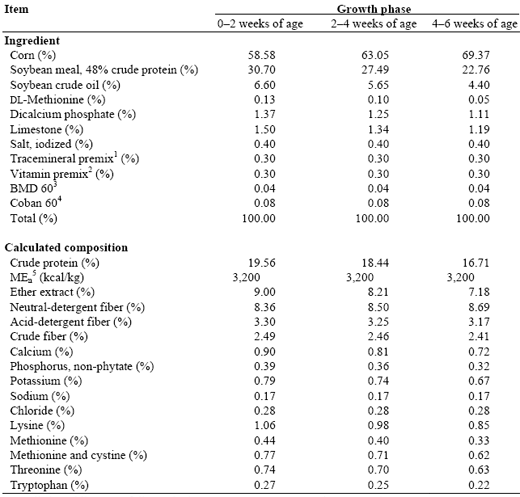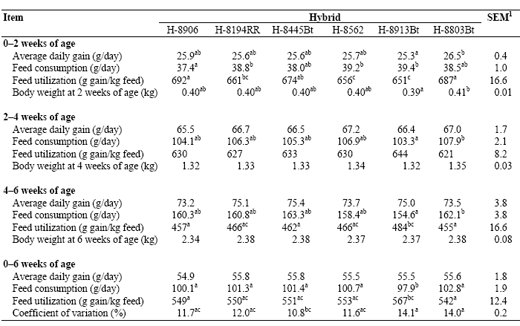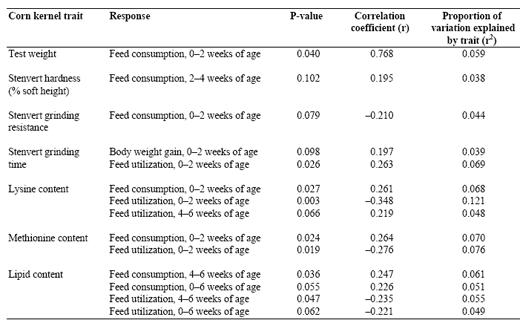Corn Hybrid Kernel Trait Variation Affects Broiler Chicken Growth Performance
Published: November 17, 2008
By: Scott Moore, Kristjan Bregendahl, Ken Stalder, Donald Beitz, Chad Stahl and Wayne Fithian - Poultry Science Day (A.S. Leaflet R2213) - Iowa State University of Science and Technology
Introduction
Broiler-chicken diets are typically based on a corn and soybean meal mixture, with the majority of the diet composed of corn. The chemical properties of the corn kernels (i.e., starch content, protein content, amino acid profile, lipid content, etc.) are mainly responsible for the nutritive value of the corn, and diets are formulated using these nutritive values. However, the physical traits of the corn may also influence its nutritive value, and thus the overall nutritive value of the diet. When formulating diets, nutritionists typically use standard nutritional values, which means that actual nutrient content of the diet may be different than that calculated using reference values. Moreover, the corn’s physical traits (e.g., test weight, density, kernel size, etc.) may also influence the nutritive value of the corn and, therefore, of the diet. Hence, when assessing the value of corn grain, both chemical and physical traits should be considered. We postulated that corn hybrids are sufficiently different in their chemical and physical composition that the use of different hybrids could cause measurable growth performance differences when used as the only variable in a corn–soybean meal diet. The objectives of this study were to determine growth performance changes in broiler chickens fed diets containing different corn hybrids and to correlate the physical and chemical traits of the corn kernels with the differences in growth performance.
Materials and Methods
A total of 720 1-day-old Ross × Ross 308 male broiler chicks (Welp Hatchery, Bancroft, Iowa) were allotted to floor pens (10 chicks per pen, 1486 cm2/chick) in a randomized complete block design. The location within the barn served as the blocking criterion. The study was carried out in two identical 6-week experiments (periods), with 360 chicks per period and 1 week between the two periods. The chicks in the first period were provided with fresh pine shaving bedding (approximately 4 in deep), while the chicks in the second period were raised on the soiled litter from the first period. The chickens were allowed free access to feed and water throughout the study. Broilers were provided light for 23 hours per day for the first week of each period, 20 hours per day for weeks 2–4 of each period, and 23 hours per day thereafter.
Experimental Diets
A single diet was formulated for each of the 3 growth phases (i.e., 0–2 weeks of age, 2–4 weeks of age, and 4–6 weeks of age). Each diet was formulated using National Research Council–published nutrient values for all ingredients (including corn) to contain inadequate amounts of essential amino acids, calcium, nonphytate phosphorus, and sodium so that small effects of corn kernel traits on growth performance could be detected (Table 1). The 6 dietary treatments for each phase were created using 6 different corn hybrids—thus the only difference among the experimental diets was the corn hybrid used. The corn was ground in a hammer mill with a 20/64-in screen immediately before diet mixing.
Corn Growth Conditions and Hybrid Kernel Traits
The 6 corn hybrids (commercially available Golden Harvest H-8906, H-8194RR, H-8445Bt, H-8562, H-8913Bt, and H-8803Bt) were grown in the same field in Webster County, Iowa, in the 2004 growing season. The corn was planted on April 27, 2004, and harvested on November 22, 2004. All cultivation practices (including fertilization rates and chemical application) were identical among the 6 hybrids. Each hybrid was planted in 60 rows, but only the middle rows were used in the experiment to minimize the use of cross-pollinated corn in the study. After harvest, 800–900 bushels of each corn hybrid were transported individually to Ames, dried, and stored in 1000-bushel gravity-flow grain bins.
Before chemical analyses, representative samples of each corn hybrid were ground through a 1-mm screen. The moisture content was determined in duplicate for each hybrid by drying at 135°C for 2 hours. Ether extract lipid content was determined in duplicate using a Goldfisch lipid extraction apparatus. The total nitrogen content was determined in duplicate using the micro-Kjeldahl method on a Kjeltech 1028 distilling unit, and the crude protein content was calculated as nitrogen × 6.25. The amino acid content was determined by ion-exchange chromatography at the University of Missouri, Columbia.
The physical traits were determined on a representative sample of each hybrid. The test weight of each hybrid was determined in triplicate using a Fairbanks test weight apparatus and corrected to a dry matter content of 88% to account for differences in moisture content. The 1000-kernel weight was measured in triplicate by multiplying the weight of 200 corn kernels by 5. The seed density was determined in triplicate using a Micrometrics AccuPyc 1330 pycnometer. The Stenvert hardness (i.e., Stenvert grinding time, Stenvert grinding resistance, and the percentage of hard and soft kernels) was determined at the University of Nebraska, Lincoln. The particle size of representative samples of the ground corn used in the diets was determined at Kansas State University with USA Standard testing sieves.
Growth Performance Data
Body weights were recorded as pen weights at the start of each experiment, at 2 weeks of age, and at 4 weeks of age. Individual body weights were recorded at 6 weeks of age in each experiment. Feed consumption (measured as feed disappearance) was recorded at 2, 4, and 6 weeks of age. Feed utilization was calculated as grams of body weight per kilogram of feed consumed. Flock uniformity was determined at 6 weeks of age as the body weight coefficient of variation (CV) for each individual pen. The CV was calculated as (standard deviation of the body weights of individual broilers in a pen / mean body weight of the broilers in the pen) × 100.
Data Analyses
Data were subjected to analysis of variance (ANOVA) according to a randomized complete block design with 12 blocks. Factors in the model were block, corn hybrid, period, and the interaction between corn hybrid and period. The effects of the 6 corn hybrids were evaluated using Fisher’s least significant difference. Because the corn kernel physical and chemical traits were expected to have small effects on growth performance, P-values of less than or equal to 0.1 were considered significant. Growth performance measures were correlated with the analyzed chemical and physical traits using linear regression. JMP 5.1 software was used for all statistical analysis.
Results and Discussion
Corn Kernel Physical and Chemical Traits
The physical traits are reported on an as-is (wet) basis, whereas the chemical traits are reported on an equal dry matter basis (i.e., 88%) to account for differences in moisture content (Table 2). The physical traits of the corn hybrids tested in this study were representative of 2004 strip plot grain quality data from Webster County, Iowa determined by the Iowa Grain Quality Initiative. The values for test weight, lipid content, crude protein and seed density of the 6 corn hybrids used in this study were all comparable to the reported means of test weight (57.5 lb/bu), lipid content (3.6%), crude protein (7.3%), and seed density (1.26 g/cm3) for corn grown in Webster County in 2004. However, the crude protein and amino acid contents of the 6 hybrids used in this study were lower than the National Research Council–published values for corn used in diet formulation.
Growth Performance
Performance measures observed in this study were generally inferior to those reported in the Ross 308 management guide, attributable to the nutrient-deficient diets. Broilers raised on fresh litter in Period 1 of the study had relatively higher body weights, feed consumption, and feed utilization than those raised on soiled litter in the Period 2 of the experiment (P < 0.1; data not shown). The only interaction between corn hybrid and period was feed utilization of broilers 4–6 weeks of age (P = 0.055), indicating that the effects of corn kernel physical and chemical traits generally do not differ between ‘clean’ and ‘unsanitary’ environments.
0–2 weeks of age. From 0–2 weeks of age, body weight gain differed by up to 4.4% (P < 0.1) depending on which hybrid was fed (Table 3), which correlated with Stenvert grinding time (Table 4), a measure of the kernel hardness. This result was likely due to differences in digestibility of the starch, because of the relationship between kernel hardness and starch type. The starch in kernels containing more of the highly branched amylopectin (as opposed to the more unbranched or linear amylose) is more digestible due to the branching of the amylopectin molecules, which provides more access points for starch-digesting enzymes. An increase in the ratio of amylopectin to amylose can contribute to an increased kernel hardness and therefore grinding time. Further tests of the corn hybrids to determine the starch content and type are necessary to determine the relationship between the Stenvert measurements obtained in this study and the amount and type of starch present in the corn kernels.
Depending on which hybrid was fed during 0–2 weeks of age, broiler feed consumption differed by up to 4.7% (P < 0.1), which correlated with lysine content, methionine content, and kernel test weight of the corn (P < 0.1). The positive correlation between amino acid content of the corn and the broilers’ feed consumption was not expected, because chickens will generally consume feed to meet their energy needs, not to meet amino acid requirements. However, there was no correlation between the lipid content of the corn, which has a large impact on the dietary energy content and feed consumption (P > 0.1). Instead, differences in starch type (starch digestibility) among the corn hybrids may have influenced the energy availability, thus affecting feed consumption. This hypothesis is supported by the positive correlation between feed consumption and corn test weight (P < 0.1) and the negative correlation between feed consumption and Stenvert grinding resistance. Both a high test weight and a low Stenvert grinding resistance value1 indicate the presence of more of the highly digestible amylopectin compared to amylose.
Feed utilization differed by up to 6.1% depending on which hybrid was fed (P < 0.1). This result correlated positively with Stenvert grinding time, and negatively with lysine and methionine contents (P < 0.1). These
observations indicate that energy availability (potentially through a greater content on the highly digestible amylopectin, suggested by the Stenvert grinding time) was more important for feed utilization than the amino acid content in the (amino acid deficient) diets.
2–4 weeks of age. The only performance measure that was affected by the corn hybrid from 2–4 weeks of age was feed consumption, which differed by up to 4.3% depending on which hybrid was fed (P < 0.1). This result correlated negatively with Stenvert soft height percentage (P < 0.1), an indication of a low amylopectin content in the corn.
4–6 weeks of age. The corn hybrids did not affect body weight gain from 4–6 weeks of age, but feed consumption differed by up to 5.4% (P < 0.1). The difference in feed consumption correlated positively with the lipid content of the corn. As a result, feed utilization differed by up to 6.1% among the dietary treatments (P < 0.1) and correlated negatively with the lipid content of the corn (P < 0.1). The broilers responded to an increase in dietary lysine content (stemming from increased lysine content in the corn) with an increase in feed utilization (P < 0.1).
0–6 weeks of age. From 0–6 weeks of age, the chickens exhibited a difference of up to 4.4% in feed consumption, and, with no significant differences in body weight gain, up to a 4.7% difference in feed utilization depending on which hybrid was fed (P < 0.1). As observed during other growth phases, feed consumption correlated positively—and feed utilization correlated negatively—with the corn’s lipid content (P < 0.1). Because broilers gain the most weight (in absolute terms) from 4–6 weeks of age, it was expected that the factors affecting growth performance during this growth phase would influence the overall (i.e., 0–6 week) growth phase to a greater degree than would the factors affecting performance in earlier weeks. Feed consumption during 4–6 weeks of age correlated with the lipid content of the corn, thus it was expected that the amount of feed consumed during this phase would influence the 0–6 weeks of age period more than the feed consumed in the other phases, which would result in a positive correlation between feed consumption and lipid content of the corn as observed. There were no differences in body weight at 6 weeks of age (P > 0.1), thus there was no difference in the overall rate of body weight gain (P > 0.1).
Implications
The physical and chemical corn kernel characteristics had small, but significant, effects on growth performance measures of broiler chickens. During 0–2 weeks of age, both physical (test weight, Stenvert grinding resistance, Stenvert grinding time) and chemical (contents of lipids and amino acids) corn kernel traits influenced growth performance, whereas only chemical traits affected growth performance in birds 4–6 weeks of age. Because of the immature digestive system in young birds, we speculate that the corn’s starch type (i.e., amylopectin vs. amylose) affect the digestion rate or extent of the starch and, therefore, energy availability and growth performance in the young birds, but not in the older birds. Further tests of the corn hybrids to determine the starch content and type are necessary to explore this hypothesis. The results of this study suggest that hybrids chosen for use in broiler chicken diets should take both physical and chemical characteristics into account and that the choice of corn should be different for young and more mature birds.
Acknowledgements
The authors would like to thank Golden Harvest Seeds, Inc., Waterloo, Nebraska, for financial support of this project. Additionally we would like to recognize Feed Energy Company, Des Moines, and ILC Resources, Des Moines, for donating feed ingredients utilized in this project. The help of the staff at the ISU Poultry Science Research Center and in Dr. Bregendahl’s lab is greatly appreciated.
1 The Stenvert grinding resistance is reported as the lowest speed in revolutions per minute that the Stenvert mill reaches under load. Relatively harder kernels require more power to grind, and thus the Stenvert mill reach a relatively lower minimum speed during grinding.
Table 1. Diet composition (as-is basis). The single diet for each phase, formulated to contain inadequate amounts of selected nutrients (see text), was formulated using nutrient values published by the National Research Council for all ingredients (including corn). Each of the 6 corn hybrids was then used to make the 6 dietary treatments within a growth phase.

2 Supplied per kilogram of diet: Vitamin A, 8065 IU; vitamin E, 15 IU; vitamin D3, 1580 IU; riboflavin, 7.8 mg; vitamin B6, 6 mg, vitamin B12, 0.016 mg; folic acid, 1.62 mg; biotin, 0.27 mg; niacin, 75 mg; pantothenic acid, 12.8 mg; choline, 509 mg.
3 Supplied per 907 kg of diet: 50 g bacitracin methylene disalicylate.
4 Supplied per 907 kg of diet: 90 g monensin.
5 Nitrogen-corrected metabolizable energy.
Table 2. Corn kernel physical and chemical traits used in the broiler chicken study.

Table 3. Broiler chicken performance measures by corn hybrid used in their diets. Data combined from Periods 1 and 2.

1 Pooled standard error of the mean, n = 12.
Table 4. Correlations between kernel traits and broiler chicken growth performance measures. Only traits that correlated significantly with production parameters are shown.

Authors:
Scott Moore, graduate research assistant,
Kristjan Bregendahl, assistant professor of animal science,
Ken Stalder, associate professor of animal science,
Donald Beitz, distinguished professor of animal science,
Chad Stahl, assistant professor of animal science, and
Wayne Fithian, Golden Harvest Seeds, Inc.
Related topics:
Recommend
Comment
Share
31 de mayo de 2011
I need some assistance if possible in identifying the correct maize cultivar in South Africa for the feeding of the Broiler industry. Did you do any more work ?
What would the posibilty of getting the correct cultivar to be produced for our broiler industry with your assistance please.
Thank you
Cornel de Villiers
Recommend
Reply

Would you like to discuss another topic? Create a new post to engage with experts in the community.







